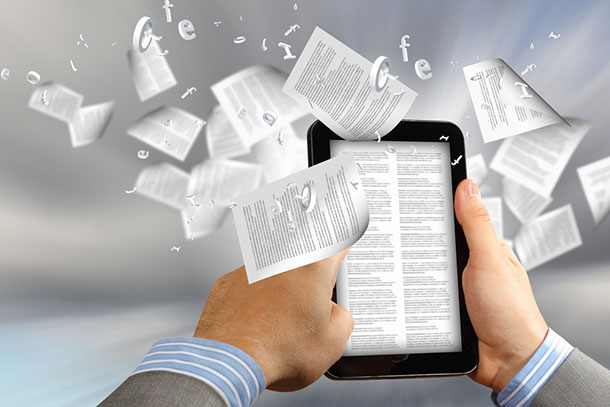 THUNDER BAY – TECH – Since the first e-reader was launched into the consumer market in the late 90s, an undercurrent of tension has threaded through the book-buying public. Will the print industry sink under the weight of its digital counterpart? Is the experience of sitting down with a good book fading into the collective consciousness? Do any of the dozens of computerized libraries capture the essence of old book smell? Well, this shift in technology has and will cause tides to change – Amazon’s e-book sales surpassed their print sales by 2011, and the Pew Research Center’s studies show that tablet ownership is exploding – but that doesn’t mean modern society will crash down around your ears. E-readers have strengths and weaknesses, just like print. You as the reader have certain wants and expectations when you reach for a book, same as when you open an ePub on your phone – and you have certain results in mind for what your experience should be.
THUNDER BAY – TECH – Since the first e-reader was launched into the consumer market in the late 90s, an undercurrent of tension has threaded through the book-buying public. Will the print industry sink under the weight of its digital counterpart? Is the experience of sitting down with a good book fading into the collective consciousness? Do any of the dozens of computerized libraries capture the essence of old book smell? Well, this shift in technology has and will cause tides to change – Amazon’s e-book sales surpassed their print sales by 2011, and the Pew Research Center’s studies show that tablet ownership is exploding – but that doesn’t mean modern society will crash down around your ears. E-readers have strengths and weaknesses, just like print. You as the reader have certain wants and expectations when you reach for a book, same as when you open an ePub on your phone – and you have certain results in mind for what your experience should be.
What You Want
Just as communication is 90 percent body language, your enjoyment of media is dependent on external factors that have little to do with the material. Even a great movie can be ruined by a crying child in the theatre – and a bad movie can be made wonderful by joking through it with friends. This argument is where printed books are strongest. Cracking the spine of a new book, using the dust jacket as a bookmark, unearthing the evidence of past readings pressed between the pages; these are all bits that make books special.
No mobile app will ever be able to replicate a coffee stain from college – not that they aren’t trying, of course. For example, there’s The Pages Project by designer Erik Schmitt, where he imports hand-marked books, page by page, onto the Internet for anyone to read the notes left by his grandfather. Still, where e-readers fall behind on accidental personalization, they make up for it in intentional, allowing for color, font, margin, and spacing edits, among other options. These two are not better or worse experiences on their own, but different ones that communicate a different end – even with the same book.
What You Expect
The flow and orientation of a piece of writing sets the pace for how you perceive it. Right now, you’re reading this article on a website. The vertical scrolling, columned layout, frequent headlines, and line breaks between paragraphs are all cues for what to expect from this page – and from most things you will read on a computer screen. However, books have always been horizontal, flipping pages sideways to further the narrative rather than endlessly scrolling down.
Think about it – how many times do you swipe to the left or right on your phone and stay on the same topic? Reading apps for Android like the Nook, which is also available for both the iOS, and Windows 8 have to combine both of these expectations into one experience, allowing you to turn the page like you want, but also keeping the vertical options you expect in a mobile environment. Moreover, apps like the Nook reader immerse you more with animations that imitate a page turning and adding fwip sounds to each flip. These help you separate ‘phone’ and ‘book’ mentally so that it’s possible to read on your iPhone without the distractions of the digital world interrupting.
What You Get
There are more avenues than ever to consume media that can affect your impression of the content. You can read the same novel in hard copy, on a dedicated e-reader, or on an app for your smartphone, and while the text never changes, you will have a separate experience each time. A hard copy’s design decisions are all made with one narrative in mind – the proportions, the typeface, the paper weight, are all conscious choices made to embody the story’s personality. An e-reader unifies everything you read with a standard format, which makes e-books easier to binge on than print, but removes the individuality. Mashable.com compares them to the movie and the musical version of Les Miserables – two equal art forms that do not replace each other, but augment the story and make it more accessible. The medium is the message, even when the message says the same thing through different mediums.
The Conclusion?
The debate between digital and traditional is complicated and vast, seeping past books into the Western cultural landscape. These shifting waters are just another step in evolution, though, and should be celebrated in time with remembering the good of what came before them.
There are countless ways to tailor your reading experience to your needs, whether it’s putting white text on a dark gray background, dog-earing every other page, or using a finger sausage in a freezing subway car, but they are all equally valid ways to read a book and should not be dismissed as greater or lesser than another.






